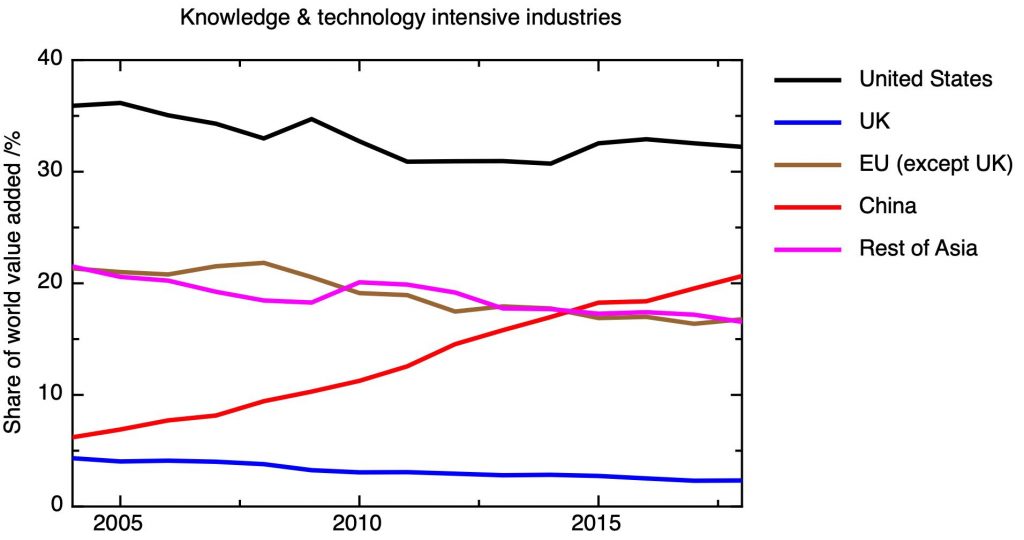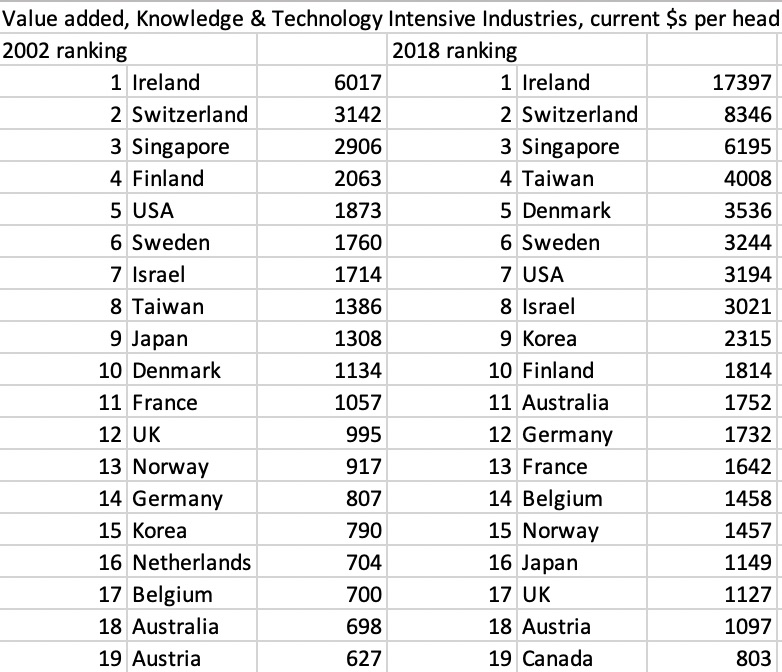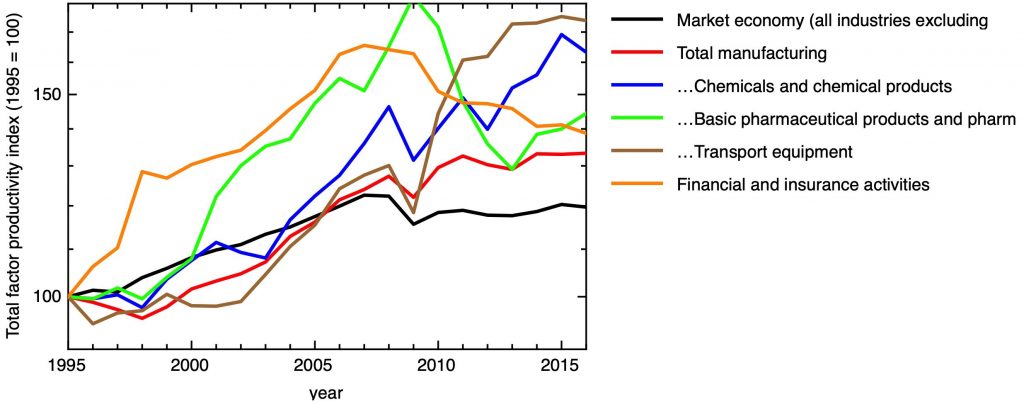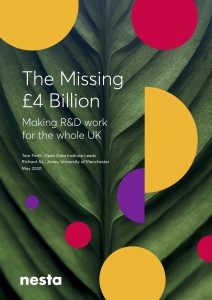The UK government published a “Research and Development Roadmap” last week, setting out “the UK’s vision and ambition for science, research and innovation”. It’s not by itself a strategy; instead it’s a document that sets out the issues that a subsequent strategy will need to address. The goals of the government here are very ambitious, and need to be thought of as part of a wider plan to remake the UK state as a global centre for science and innovation, after its departure from the European Union. In the recent words of the Prime Minister, “though we are no longer a military superpower we can be a science superpower”. Does this Roadmap give us a realistic route for translating this aspiration into policy?
What’s at stake?
The context for the roadmap is the commitment to raise the UK government’s R&D spend to £22 billion by 2024/25. The roadmap is important as a reassertion of this goal, set in the March 2020 budget, despite the strains that the pandemic have put on the public finances.
What does this mean in practise? Total government spending on R&D was £12.8 billion in 2018 (the most recent year for which full figures are available). The implication is that this must rise by £1.5 billion per year on average. This amounts to introducing new spending amounting to the total budget of two large research councils (e.g. EPSRC and BBSRC combined), every year. There is very little clarity of how this is planned to happen. Will the change be evolutionary – just increasing spending through existing institutions, or revolutionary – introducing entirely new, large scale institutions, agencies and mechanisms?
In very rough terms (rounded to the nearest half billion), Research Councils spend £4 billion a year, another £2.5 billion go to Universities through Research England and the devolved nations’ funding agencies, and InnovateUK gets a bit less than £1 billion. This is now bundled up in UKRI (except university funding in devolved nations). We’ve seen a £1.5 billion increase for UKRI in 2020/21, mostly in new funding instruments like the Industrial Strategy Challenge Fund.
But it’s important to remember that the Research Councils are not the only means by which the government spends money on R&D. £1 billion goes into health research, mostly through the Department of Health’s National Institute for Health Research, £1.5 billion is spend on defence R&D by MoD, and BEIS spends a bit less than £1 billion outside UKRI (e.g. for space, UKAEA for the fusion programme, the National Physical Laboratory, and various industry programmes). The other government departments spend about another £1 billion between them.
Finally, the UK Government spends money indirectly via its participation in the EU programmes. This amounts to another notional £1 billion.
What are the government’s current imperatives?
Where will the extra £1.5 billion a year go? Choices will be steered by the government’s current and emerging priorities. Here is a (no doubt) incomplete list, in no particular order:
Increasing business R&D. The £22 billion is the government’s contribution to a bigger target – to increase the UK economy’s total R&D intensity from its current proportion of 1.7% of GDP to 2.4%. But most R&D comes from the private sector, in a roughly 2:1 ratio. So to achieve the overall target, the public money must be deployed in a way that maximises the chance of the private sector increasing its own spending in that 2:1 ratio. What will best persuade businesses – both UK owned and overseas owned – to spend another £18 billion or so a year on R&D in the UK?
Translating R&D spending into economic outcomes. The current economic crisis makes this even more pressing, so there will be even more emphasis on interventions which will plausibly lead to productivity increases and new jobs, on timescales of years rather than decades.
“Levelling up.” The economic underperformance of the UK outside the greater Southeast – including the relative underperformance of core cities like Manchester, the difficulties of deindustrialised towns and urban fringes, and the economic and social problems of rural and coastal peripheries, have achieved real political salience as the electoral centre of gravity of the Conservative party has moved north. The concentration of public R&D resources in the prosperous Southeast – as Tom Forth and I recently highlighted in our NESTA “Missing £4 billion” report – is increasingly recognised as part of the problem.
Solving big societal problems. I believe the commitment of the government to net zero greenhouse gas emissions by 2050 is serious, but I don’t think policy makers yet realise the full scale of this economic transition. As this realisation takes hold the expectations on innovation and technology to deliver affordable solutions will only increase. Meanwhile the aftermath of the pandemic will prompt a reassessment of whether our “life sciences sector” has the optimal shape to support national health and well-being. The problems the UK is having in deploying a large-scale testing programme illustrate that strength in biotech and pharmaceutical research doesn’t automatically translate into diagnostic capacity. If and when vaccines and antibody therapeutics for COVID come on stream, there will be a tough test of the UK’s manufacturing capacity in the face of worldwide demand.
Perceived problems in the culture of research in the UK and internationally. There is a strong perception in parts of government that all is not well in the culture of research in the UK. There’s a view that research culture itself is unhealthy, with insufficient autonomy for younger researchers and problems in the career structure, while the culture of funding bodies is believed to be too risk averse and bureaucratic.
Life after Brexit. The position of UK science in an international context is clearly in question in the aftermath of Brexit. The immediate problem is the nature of the UK’s relationship with the EU’s science programmes. It’s clear that there is a desire for the UK to associate with Horizon Europe, but this is a second order issue for the government so if negotiations falter for other reasons then this may not happen, in which case there will be a need to find replacement programmes (particularly for the ERC, which is highly prized by the science establishment). The longer term issues are the nature of scientific relationships with other existing and emerging and science powers, and ensuring an openness to scientific talent from the rest of the world.
Economic and technological sovereignty. Finally, the rapidly changing attitude of the government to China has raised questions of the degree to which the UK can be autonomous in key areas of strategic technology. The saga of Huawei’s involvement in the 5G network, questions about the involvement of China in the nuclear new build programme, and a realisation of the limitations of global supply chains in the pandemic, have led to talk of retaining or rebuilding some of the UK’s technological sovereign capability in key areas. I don’t think policy makers yet fully appreciate how much this capability has been run down over the last few decades.
Possible new policies suggested by the Roadmap
The roadmap reads as a rather open-ended document, but within it are some strong hints and indications of possible new policy directions. Here I’ve tried to extract some possible new policies that seem to be being suggested, expressing them in a more concrete way than the Roadmap does, where necessary reading between the lines, and possibly on occasion extrapolating somewhat. I’ve suggested some of the questions that these proposals might provoke. We need to keep in mind the scale of interventions implied by the £22 billion target – i.e. £1.5 billion additional spending each year, in considering these possible new policies.
Raising our research ambitions
New mechanisms for funding will be introduced, which involve less bureaucracy and taking bigger bets: more long-term, investigator-led funding. The new UK-ARPA like agency is already announced, but at £200m a year this is relatively small. It will sit outside UKRI. Will any other new mechanisms be left to the research councils, or can we expect more new agencies to be created?
Defense-related R&D could be substantially increased. This would address the funding gap for development relative to research, and it’s a sector in which there is existing capacity which could be expanded – in both the public and private sectors. But how can we avoid the waste that defense procurement is often accused of, and maximise spillovers to the civilian economy?
The government will fund large-scale “Moonshot” projects. Again, if done seriously this would lead to more development funding. What do we mean by a “moonshot”? To me, it needs to be an ambitious, engineering project that delivers a concrete outcome (i.e. at least a full scale prototype) on a defined timescale, but which is difficult enough that it drives a substantial associated R&D programme to solve the problems that arise on the way. The questions it prompts include – how would we select them, how can we be confident that the UK has the capacity to deliver, what scale of spending is involved? My first guess on the latter question is that if this isn’t measured in £ billions it’s either not a proper moonshot or we’re not serious about succeeding.
What are possible concrete examples?
An all electric long haul aeroplane, as mentioned in the Prime Minister’s recent speech. (I think this is technologically implausible – my guess now is that if we want long-haul flying in a zero carbon world we will do it by making synthetic hydrocarbon fuel from green hydrogen and carbon dioxide captured directly from air).
A generation 4 advanced modular fission reactor which is low waste, intrinsically fail-safe and generates enough process heat to produce hydrogen as well as electricity (I think the government should do this).
A working, scalable, quantum computer (In my view this would be an example of a bad choice because the UK is not competitive with existing major projects elsewhere in the world).
A commercial fusion reactor supplying significant, low cost electricity to the grid by 2040 (i.e. STEP – the Spherical Tokomak for Energy Production. I think the government will do this, and it probably should, in case it works.)
Inspiring and enabling talented people and teams
A big increase in R&D spending won’t deliver results if there aren’t the talented people – at all levels – to do the work. Much potential homegrown talent is currently missed, due to the underrepresentation of women and black and minority ethnic people in research. The roadmap announces the creation of an “Office of Talent” to make it easier for overseas researchers to work and settle in the UK.
The relationship between higher education and further education will be rethought, especially in the context of expanding intermediate level technical training. I believe that we need much more joined-up systems for further and higher education on a regional basis, with much easier routes between the different parts of the system, and much more cooperation to expand provision for adult and continuing education.
Catapult Centres could be given a more explicit mandate to embrace technical training in their missions. Again, this needs to be done in a regional context, working with existing HE and FE institutions.
There will be an expansion of postgraduate research training. Will responsibility for PGR training be left with the research councils? Do we think of PhD students as primarily researchers or as trainees? Currently, PhD students are funded at a level far below the actual cost of training them, so given the current financial difficulties of universities the appropriate funding level will need to be reconsidered.
Innovation and productivity
The proportion of public R&D funding devoted to translational and applied research will be increased, with a particular focus on new medicines and treatment, and on defense research. What agencies will this funding be pushed through? Will funding for NIHR be substantially increased? What will be the role of Innovate UK?
Universities will be further incentivised to carry out knowledge exchange activities: HEIF funding is being increased, and the Knowledge Exchange Framework introduced. Care will be needed to create the right incentives here – perhaps they could be structured to encourage more regional collaboration between institutions?
The Catapult Network of translational research institutes could be restructured “We will review whether they should all continue in their current form, exploring the potential to seize new opportunities.” There’s a broader question of whether the Catapult Network should continue to be run by InnovateUK, or developed as an independent translational research agency with greater central coordination?
New innovation zones and clusters should be created, based around existing and new innovation assets such as Catapult Centres, and the role of Catapult Centres in promoting local and regional economic growth made more explicit in their goals. What is the right balance between the regional and national missions of Catapult Centres?
Levelling up R&D across the UK
“We have already committed to developing a comprehensive and ambitious UK R&D Place Strategy together with the devolved administrations over the coming months.” Tom Forth and I have published a comprehensive set of suggestions for “levelling up” in our recent NESTA paper “The Missing £4 billion”.
Central government will support local leaders in co-creating effective innovation approaches for their local economies. Should this be made formal, with cities/regions coming forward with “innovation deals” in return for devolved funding, as Tom Forth and I suggested?
Some proportion of national R&D funding should be ring-fenced for particular regions, in order to make progress towards “levelling-up” R&D funding across the country, and/or devolved to those cities and regions that have demonstrated the capacity to create robust innovation strategies. How much of the “levelling up” agenda should be driven top-down as opposed to created bottom-up?
All future decisions on R&D infrastructure investments should include an explicit consideration of their impacts on local and regional economies. This commitment is explicitly made in the Roadmap, though the issue will be the weight that is in practise attached to these factors relative to national considerations.
There should be mechanisms for more local and regional voices in the advice given to central government agencies. The emphasis so far has been on UKRI, but what about NIHR, MoD, and any new agencies that emerge?
Being at the forefront of global collaboration
The immediate question here is what happens to the UK’s participation in EU science programs. The stated intention is to negotiate participation in Horizon Europe and the Euratom research programme – but there is an if: “It is our ambition to fully associate to both programmes if we can agree a fair and balanced deal”. So there is a plan B:
“If we do not formally associate to Horizon Europe or Euratom R&T, we will implement ambitious alternatives as quickly as possible from January 2021 and address the funding gap. As a first step we will launch an ambitious new Discovery Fund offering sizeable grants over long periods of time to talented early, mid and late-career researchers, whether already in the UK or coming here from anywhere in the world, to pursue discovery-led, ground- breaking research.” This is clearly intended as a substitute for the European Research Council. One shouldn’t underestimate the difficulty of rapidly establishing a single-nation programme that reproduces the rigour and credibility of the ERC.
More funding will be made for bilateral programmes with appropriate national partners across the world, in a way that is more responsive to new opportunities. This in part is a response to a long-standing complaint by Science Ministers that they don’t have any flexibility to assign such funds during overseas visits, but this raises the problem of how to make the choice of partner countries strategic rather than simply depending on the travel schedule of the Minister. European partners shouldn’t be neglected here.
Ensuring a healthy R&D system
Public sector research establishments (PSREs) will be strengthened and integrated into the wider system. They will be allowed to bid for funding from UKRI, which should come with full economic costs. What is the right division of labour between university-based research and R&D in PSREs? Is there a danger of the two parts of the system entering into sub-optimal competition?
The PSRE network will be integrated into a true network of national laboratories, strengthened where necessary, with new organisations being created to fill obvious gaps. This needs a very clear view of national strategic priorities. One answer to the previous question is to differentiate more clearly between strategic science in support of national priorities and discovery science, but then this needs clarity about how universities and PSREs can most effectively collaborate.
My concrete suggestion would be to create a new “Net Zero Delivery Agency” to take responsibility for the innovation that will be needed to reach the net zero greenhouse gas goal.
The Government Office for Science will be strengthened and its resources increased, so that it can coordinate better science advice government and act as an authoritative technology assessment agency. Increased funding for GO Science was announced in the March budget, which I welcome.
The Research Excellence Framework will be reformed to reduce its bureaucratic overhead and focus more on measuring change and development. How to do this without introducing perverse incentives?
University research will be funded at closer to full economic cost. Part of the reason that a larger proportion of the UK’s public research enterprise happens in universities than in other comparable countries is that this has seemed a cheaper way of doing research than carrying it out in free-standing research institutes. But, as we’re now about to find out, that’s been an illusion – in reality, universities have subsidised the cost of research using the surplus from teaching overseas students. This subsidy – amounting to about a couple of billion pounds a year across the system – has been dramatically exposed by the pandemic.
What’s next?
The last section of the document begins by saying: “This Roadmap is the start of a conversation”. This conversation needs to take place with some speed: over this summer and autumn, the government needs to put in place its future spending plans in a Comprehensive Spending Review. In normal times, we’d expect this to cover the next three years – 21/22, 22/23 and 23/24. It’s the year after that – 24/25 – that the commitment to £22 billion R&D spending has been made, so these three years need to see substantial progress towards reaching that target, with concrete plans for those £billion scale increases. But it takes time to build new institutions, to recruit suitable people, to make evidence-based decisions about what projects to support.
It’s natural to ask, how robust will this spending target, and the general priority being attached to R&D, be to the shifting winds of politics? While the commitment of the current Number 10 operation to R&D seems not to be in doubt, it’s not obvious that there’s a deep commitment to research throughout the Conservative Party. It’s not difficult to imagine circumstances – perhaps a change in leadership following the inevitable economic difficulties that we’ll encounter recovering from the pandemic – in which that commitment will be diluted.
Of course, the spending target isn’t the ultimate goal, it’s the means to an end. That end is a more prosperous, more productive nation, with prosperity spread more equally across the country, on track to rapidly move its energy economy to a sustainable, net zero greenhouse emissions, basis. It is these goals that should drive our emerging R&D strategy.



